Ann Arbor Elections Past: Voting Patterns
Tea leaves, tarot cards, crystal balls – predicting the future is a popular pastime. But here at The Chronicle, we decided to take a look at past elections – with an eye towards the approaching Aug. 2 primary elections for the Ann Arbor city council.
Ann Arbor residents are represented by the mayor and 10 other elected members on the city council – two for each of the city’s five wards. Each year, one of the pair of councilmembers stands for re-election to a two-year term. This year, three members of the currently all-Democratic council have contested races in the primary, which falls on Tuesday, Aug. 2.
In Ward 5, incumbent Mike Anglin is challenged by Neal Elyakin. In Ward 3, incumbent Stephen Kunselman is challenged by Marwan Issa and Ingrid Ault. And in Ward 2, incumbent Stephen Rapundalo is challenged by Tim Hull.
Each of the city’s five wards is divided into precincts.
In this article, The Chronicle takes a look at the incumbents’ performance in past elections, mapped out by precinct. Some descriptive generalizations are readily apparent in the data – the strength of incumbents has not been uniform across their respective wards.
And in some cases, it’s possible to offer a speculative analysis that could account for some of those patterns.
Ward 5
Ann Arbor’s Ward 5 covers the central, western part of the city.
Ward 5: August 2009 – Anglin, Rosencrans
Map A shows results for the 2009 Democratic primary election for Ward 5 between incumbent Mike Anglin and challenger Scott Rosencrans. [Washtenaw County clerk's office results] Anglin successfully defended his seat, winning the election with 65% of the vote (1,301 votes to 694). This map plots Anglin’s relative success in the 11 precincts of Ward 5. The pushpins indicate where each candidate lives, and the black lines mark the individual precinct boundaries of the ward.
The shade of blue corresponds to Anglin’s relative success in a precinct. A darker shade of blue means Anglin received a higher percentage of votes in that precinct. For example, Anglin performed strongest in precinct 5-10, located in the northwestern corner of the ward, where he received 78.9% of votes. So 5-10 is the darkest shade of blue on the map. For those lighter blue parts of the map, Anglin received a lower percentage of votes. He was least strong in precinct 5-8, receiving 52.5% of votes. So precinct 5-8, located directly below 5-10 in the western part of the ward, is the lightest shade of all the precincts.
Ward 5: August 2007 – Anglin, Woods
In the 2009 election, Mike Anglin was defending his seat on the council. But two years earlier in 2007, he was the challenger to Wendy Woods, who had been serving Ward 5 since 2001. Map B shows results for the 2007 Democratic primary election for Ward 5 between Anglin and Woods. Anglin defeated the incumbent, winning the election with 60% of the vote (989 votes to 671). [Washtenaw County clerk's office results] Like Map A, this map plots Anglin’s relative success in the 11 precincts of Ward 5. The pushpins indicate where each candidate lives, and the black lines mark the individual precinct boundaries of the ward.
In the 2007 Democratic primary, Anglin performed strongest in precinct 5-2, the precinct in which he lives, receiving 66.9% of votes. So 5-2 is the darkest shade of blue on the map. He was weakest in precinct 5-7, receiving 21% of votes. Precinct 5-7, farthest south, is the lightest of all the precincts.
Ward 5: Descriptive Generalizations
In comparing the two elections, Anglin was not consistently strongest or weakest in the same precincts. For example, in the 2009 election against Rosencrans, Anglin won 78.9% of the vote in precinct 5-10, making it his strongest precinct. But two years earlier, against Wendy Woods, 5-10 was his second-weakest precinct, after 5-7. In fact Anglin lost precinct 5-10 against Woods, garnering only 44.6% of the vote.
Even though 5-7 was Anglin’s weakest precinct against Woods (21%), it was one of his three strongest precincts against Rosencrans. The relatively low total number of votes in that precinct (29 in 2007 and 50 in 2009) means definitive conclusions about reasons for the flip are difficult. But City-Data.com shows one-third of residents of that area of the city to be African American, compared with 6.5% citywide. To the extent that African American neighborhoods might tend to support an African American candidate, like Woods, her strong showing there could partly be explained.
In the 2009 contest against Rosencrans, the flip of 5-7 to one of Anglin’s strongest precincts could be accounted for by the overlap of an active neighborhood association with the precinct – Friends of Dicken Woods. The leadership of the association includes Jack Eaton, who supported Anglin’s campaign.
Where each candidate lived had a discernable impact in some cases, but did not seem to be a key factor determining the outcome of the election. In 2007, Anglin did fare best in his home precinct, receiving 66.9% of votes. But Anglin’s performance was about as strong in many other precincts. For example, he received 66% of the vote in precinct 5-11.
Anglin’s opponents also did not appear to enjoy enough of an advantage in their home precincts to have a clear effect on election results. In 2009, Anglin was weakest in precinct 5-8, where his opponent Scott Rosencrans lived – but Anglin still carried that precinct with 52.5% of the vote. And in 2007, one of Anglin’s strongest precincts was the home precinct of his opponent, Wendy Woods – in 5-5 Anglin received 63% of the vote.
Ward 3
Ann Arbor’s Ward 3 covers a wedge of the city starting near the center and widening out towards the southeast.
Ward 3: August 2009 – Kunselman, Bullington, Greden
Map C shows results for the 2009 Democratic primary election for Ward 3, contested by Stephen Kunselman, LuAnne Bullington, and incumbent Leigh Greden. At that time Kunselman had served on city council from 2006-2008, before Christopher Taylor defeated him in the 2008 Democratic primary.
In 2009, Kunselman narrowly won back his seat, winning 511 votes (36.45%) to Greden’s 505 and Bullington’s 382. [Washtenaw County clerk's office results] The map plots Kunselman’s relative success in the nine precincts of Ward 3. The pushpins indicate where each candidate lives, and the black lines mark the individual precinct boundaries of the ward.
The shade of purple corresponds to Kunselman’s relative success in a precinct. A darker shade of purple means Kunselman received a higher percentage of votes in that precinct. For example, Kunselman performed best in precincts 3-1 and 3-2, the two side-by-side precincts in the northwestern tip of the ward. Kunselman received 66% of the vote in the two precincts combined. [Note: Because the two precincts were recorded and reported together, the same percentage is assigned to both precincts.]
So precincts 3-1 and 3-2 are the darkest shades of purple on the map. For those lighter purple parts of the map, Kunselman received a lower percentage of votes. He performed weakest in precinct 3-3, receiving 27% of votes. So precinct 3-3, the precinct where LuAnne Bullington lives, is the lightest of all the precincts.
Ward 3: August 2008 – Kunselman, Taylor
In the August 2008 Democratic primary, Kunselman was challenged and defeated by Christopher Taylor, receiving only 805 votes (36.7%) to 1,387 for Taylor. [Washtenaw County clerk's office results] Map D shows results for the 2008 Democratic primary between Kunselman and Taylor.
Like Map C, the shade of purple corresponds to Kunselman’s relative success in a precinct. A darker shade of purple means Kunselman received a higher percentage of votes in that precinct. So the darkest shade of purple on the map is in Kunselman’s home precinct, 3-6, where he received 57% of the vote. Other precincts in the southeastern end of the ward are also relatively darkly shaded. Kunselman received 55% of the vote in 3-5 and 52% in 3-9.
The map shows the lightest shades of purple in precincts 3-3 and 3-4, where Kunselman polled only 19% and 25%, respectively.
Ward 3: August 2006 – Kunselman, Ralph, Meyers
Map E shows results for the 2006 Democratic primary election in Ward 3 between Stephen Kunselman, Alice Ralph, and Jeff Meyers. Kunselman narrowly won the three-way race, getting 663 votes (36.8%) to Ralph’s 634 and Meyers’ 505. [Washtenaw County clerk's office results] The three were contesting the seat left open by Jean Carlberg, who decided not to seek another term.
Like Maps C and D, the shade of purple corresponds to Kunselman’s relative success in a precinct. A darker shade of purple means Kunselman received a higher percentage of votes in that precinct. Kunselman was strongest in precinct 3-6, his home precinct, receiving 54.9% of the vote. So precinct 3-6 is the darkest shade of purple on the map. He performed the weakest in precinct 3-3, receiving 20.7% of votes. So precinct 3-3, the precinct where both Alice Ralph and Jeff Meyers live, is the lightest of all the precincts.
Ward 3: Descriptive Generalizations
In comparing the three elections, Kunselman’s weakest precinct was consistently 3-3. In every election, precinct 3-3 was home to at least one of Kunselman’s opponents – in 2006, both opponents lived in 3-3. That may help to explain Kunselman’s weak performance in that precinct.
Kunselman’s very strongest precinct has varied. In the combined results of 3-1 and 3-2 in 2009, Kunselman polled 66%. Even though those two precincts combined offered only 68 total votes, the election was decided by just 6 votes. So the strength of his showing there, in predominantly student districts, may have been decisive in his victory.
Consistently strong for Kunselman has been his home precinct of 3-6. He’s carried the 3-6 precinct in all three elections, even in 2008, when he lost 3-3 with only 19% of the vote (in a two-person race) in that precinct.
The contrast between 3-6 and 3-3 is likely not just a matter of their geographic proximity to Kunselman and his opponents’ home neighborhoods. According to City-Data.com, the median household income in 2009 for the North Burns Park chunk of precinct 3-3 was $109,000, and for another chunk of it, south of Burns Park, the median household income that year was $91,000. In contrast, precinct 3-6 includes large blocks where the 2009 median household income ranges between $40,000-$55,000.
In this year’s candidate forums, Kunselman has spoken as a point of emphasis about his support throughout the entire ward.
Ward 2
Ann Arbor’s Ward 2 covers the northeast part of the city.
Ward 2: November 2007 – Rapundalo, Amonsen
The most recent Ward 2 election in which incumbent Stephen Rapundalo was challenged took place in the general election of 2007 – he wasn’t challenged in the Democratic primary that year, nor was he challenged in 2009. Ed Amonsen was a write-in candidate for the 2007 general election.
Map F shows results for the 2007 general election for Ward 2 between Stephen Rapundalo and Ed Amonsen. Rapundalo successfully defended his seat, winning the election with 51.6% percent of the vote – 843 votes to 790. [Washtenaw County clerk's office results] This map plots Rapundalo’s relative success in the nine precincts of Ward 2. The pushpins indicate where each candidate lives, and the black lines mark the individual precinct boundaries of the ward.
The shade of green corresponds to Rapundalo’s relative success in a precinct. A darker shade of green means Rapundalo received a higher percentage of votes in that precinct. For example, Rapundalo performed best in precinct 2-2, the small precinct in the western part of the ward. Rapundalo received 100% of votes – but only two people voted in that precinct.
A more relevant example of his strong performance is precinct 2-9, located in the northern tip of the ward, where he received 80.3% of votes. Of the precincts that had any kind of voter turnout, 2-9 is the darkest shade of green on the map, followed by 2-6. For those lighter green parts of the map, Rapundalo received a lower percentage of votes. He performed weakest in precinct 2-5, receiving 25.1% of votes. So precinct 2-5, located in the southeast corner of the ward, is the lightest shade of all the precincts.
Ward 2: November 2005 – Rapundalo, Bourque
While Stephen Rapundalo successfully defended his seat in 2007, he first ran for city council in 2005. Map G shows results for the 2005 general election for Ward 2 between Rapundalo and Republican Thomas Bourque. Rapundalo won the election with 1,574 votes (52%) to 1,436. [Washtenaw County clerk's office results] This map plots Rapundalo’s relative success in the nine precincts of Ward 2. The pushpins indicate where each candidate lives, and the black lines mark the individual precinct boundaries of the ward.
As in Map F, the shade of green corresponds to Rapundalo’s relative success in a precinct. A darker shade of green means Rapundalo received a higher percentage of votes in that precinct. Rapundalo performed best in precinct 2-2, located in the western corner of the ward, receiving 80% of votes. So 2-2 is the darkest shade of green on the map. He performed the weakest in precincts 2-3 and 2-4, receiving 40.8% of votes. So precincts 2-3 and 2-4 – Bourque’s home precinct and its neighbor to the west – are the lightest shades of all the precincts.
Ward 2: August 2005 – Rapundalo, Kang
Rapundalo contested the August 2005 Democratic primary with Eugene Kang, who was then a University of Michigan student. That was five years after then-Republican Rapundalo contested the 2000 mayoral race against John Hieftje. Rapundalo lost that race.
But Rapundalo won the 2005 Democratic primary race, 575 votes (54.5%) to 480. [Washtenaw County clerk's office results] Map H shows results of that 2005 primary. As in Maps F and G, the pushpins indicate where each candidate lived, the black lines mark the individual precinct boundaries of the ward, and the shade of green corresponds to Rapundalo’s relative success in a precinct.
The darkest precincts are 2-6 and 2-9, where Rapundalo made his strongest showing – 73% and 71% respectively. In the middle three precincts – 2-1, 2-8 and 2-7 – his support was weakest, ranging from 36% to 45%. The southern precincts – 2-3, 2-4 and 2-5 – were fairly evenly split between Kang and Rapundalo and are thus a medium shade of green. In fact the result in 2-4 was a dead heat, with Rapundalo and Kang getting 77 votes apiece.
Precinct 2-2 is completely transparent, because no one voted for Rapundalo there – but that is because no voters showed up in that precinct.
Ward 2: Descriptive Generalizations
While precinct 2-2 was percentage-wise Rapundalo’s strongest in November 2005 and August 2007, in both of those elections, the precinct also had an inordinately low number of total votes – two in August 2007 and fifteen in November 2005. And in August 2005, no one from that precinct showed up to vote. So precinct 2-2 does not factor prominently in the patterns of Ward 2 elections.
The most striking pattern in assessing Rapundalo’s support is how consistently dominant he is in precincts 2-6 and 2-9, which are both in Rapundalo’s immediate neighborhood – Rapundalo lives right on the boundary of the two precincts, in 2-9. In the 2005 primary, Kang was stronger through the middle of the ward, and the candidates were about even across the southern precincts, so those two northern precincts made the difference in the outcome for Rapundalo.
Also in the 2007 and 2005 general elections, those two northern precincts were crucial for Rapundalo. In both of those elections (against Amonsen and Bourque, respectively), if the result had been based just on other precincts, Rapundalo would have lost both elections. Especially in the 2007 race against Amonsen, the southern precinct 2-5 was weak for Rapundalo. That was not just because it is Amonsen’s home precinct. It’s also home to Huron Hills golf course. A perception at the time was that the city was possibly planning to sell the golf course, and that’s what in part prompted Amonsen’s write-in campaign.
It was crucial in both of those elections not just that Rapundalo carry his home precincts, but that he carry them with a high plurality.
Rapundalo’s strength in those precincts is not just a matter of living in the neighborhood. He’s a past president of his homeowners association – the Orchard Hills/Maplewood Homeowners Association – and remains active with the group.
In a 2005 interview, about two months after the election, Bourque reflected on the strength of neighborhood connections and why voters choose one candidate over another:
But they also had to have some kind of personal knowledge or at least try and find out if anybody knew me. I think that’s why Stephen Rapundalo probably won. Because he knew a whole bunch of people in his neighborhood. … And that’s where, from a vote standpoint, he killed me. In his neighborhood he essentially beat me 2-to-1. And that makes sense. A lot of people knew him and said, I know this guy and I can trust him.
… And you kind of wonder how much of it was the ‘D’ [Democrat] influence and how much was the people he knew. There’s no way to know that. There’s no way we’ll ever know it. Actually other than me and maybe him …. no one will really care!
About the writer: Saline resident Hayley Byrnes is a Chronicle intern. The Chronicle relies in part on regular voluntary subscriptions to support our coverage of elections to public bodies like the Ann Arbor city council. Click this link for details: Subscribe to The Chronicle. And if you’re already supporting us, please encourage your friends, neighbors and colleagues to help support The Chronicle, too!




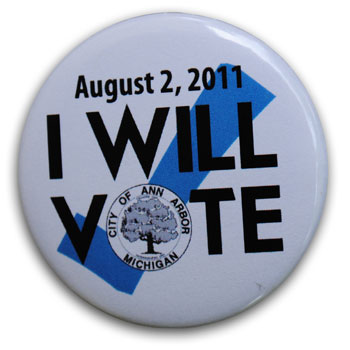
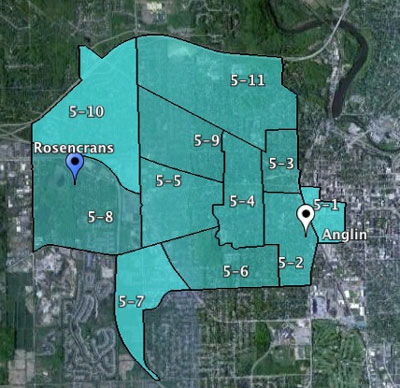

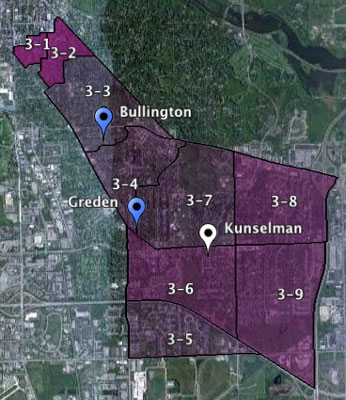
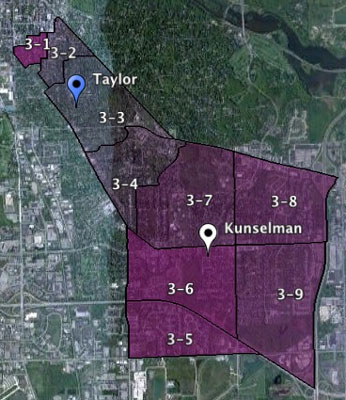
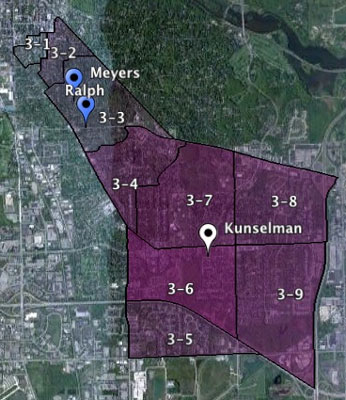
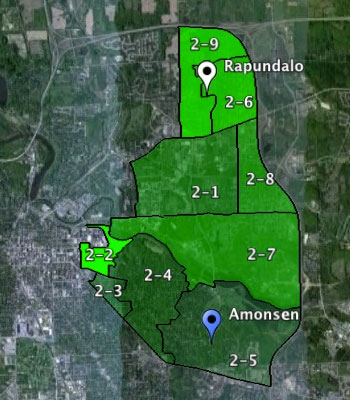
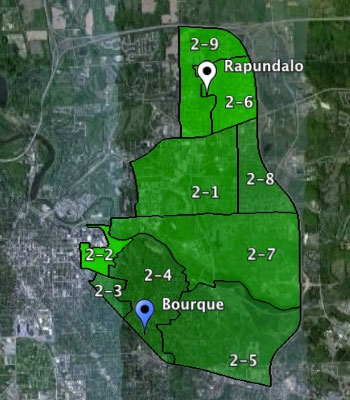

This is an impressive analysis.
What I have counseled candidates about primaries in particular is that it is all about getting your own voters out. It isn’t about what the pool of voters in your ward think. It is about what the people who care enough about you and what you are saying think. It doesn’t matter what the general mass of voters’ opinions are. It is whether they are sufficiently motivated to vote.
I live in 5-10 and I’ve noted a lot of Mike signs along Sunset. On the other hand, Neal Elyakin signs along his immediate location on Red Oak are dense.
As you say, it’s about who has a personal interest.
I think there are graphic errors on these maps. The precincts you call the “darkest” are, in my display at least, the “lightest”. Could you please recheck?
Re: [2] I don’t think there are graphic errors, nor do I think that there’s anything wrong with your monitor. But we might disagree about what “darker” and “lighter” can mean.
In the technical terms of Google Maps, “darker” corresponds to “more opaque” and “lighter” corresponds to “less opaque.” Precinct 2-2 in Map F is “darkest” for the green color (100% opacity for the color) compared with Precinct 2-2 in Map H which is “lightest” for that green color (0% opacity for the color or completely clear).
On analogy with using crayons to color something, the harder you press, the more color you lay down, and the “darker” that color is. If you ask a kid to “make it darker” then she’ll bear down more with the crayon. If you do that against a relatively dark background (like the satellite map), then “darker” is going to be brighter.
We went with a common descriptive term instead of using “opacity” because we figured that term would not be accessible to many readers. It’s possible that “brighter” and “dimmer” as a contrastive pair instead of “darker” and “lighter” could have been a better choice.
In any case, the percentage opacity of the colors does match the percentage of the vote received by the candidate. I hope you’ll find it possible to interpret all the maps based on the contrast between precinct 2-2 in maps F and H, even if you think to yourself, “Okay, but that’s not what ‘darker’ means.”
Thank you for the fine analysis.
I have previously passed out campaign flyers at the polls in primary and general elections in Ann Arbor and have noticed that some precincts are almost all student voters from U-M in in general elections. The number of U-M students voting in the primary elections is far less.
In 2008, about 10,000 new U-M student voters registered and attempts were made in the general election to target these precincts that had large student voter registrations.
In 2009, Hatim Elhady bypassed the Democratic City Council primary in the Fourth Ward and filed as an independent candidate against Marcia Higgins in the general election to try and take advantage of the perceived role of the student vote – but his strategy backfired as many Ann Arbor Democratic Party leaders had predicted.
The current idea of having a partisan municipal primary in August is rare in Michigan and one that I believe unfairly and likely intentionally skews the playing field against the student voting population.
Youseh Rabhi is the only U-M student in recent years that has bucked this trend and gotten elected as a student, albeit at the county level.
Re (4), I wrote an extensive study of that 2009 race [link] with some history of how we got primaries in August and discussion of the student vote issue.
Yousef Rabhi didn’t run a student-only campaign but reached out to a broad spectrum of District 11 voters. He had a long history of involvement in the Ann Arbor Democratic Party and many friends of all ages.
Thanks for a great analysis. I would quibble with the statement that “the flip of 5-7 to one of Anglin’s strongest precincts could be accounted for by the overlap of an active neighborhood association with the precinct – Friends of Dicken Woods.”
The Friends of Dicken Woods do not get involved in politics. But a broader coalition of neighbors – the South Maple Group [http://www.southmaple.org] – had just lost a difficult fight over the 42 North development within the 5-7 precinct.
It was not the South Maple group that brought support to Mr. Anglin. Rather, he introduced us to residents of 5-7 who joined our opposition to 42 North. Council Member Anglin was a strong ally of the neighbors in that effort. It is his strong support of neighborhoods that earns him our respect.